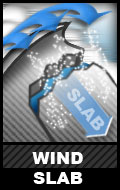Avalanche Danger Update
Avalanche danger has increased due to continued strong winds, combined with fresh snow in some areas. Dangerous avalanche conditions. Careful snowpack evaluation, cautious route-finding, and conservative decision-making essential. Natural avalanches possible; human-triggered avalanches likely. Small avalanches in many areas; or large avalanches in specific areas; or very large avalanches in isolated areas.
Avalanche danger is expected to continue to increase through today, and peak sometime tonight or early Monday morning. Dangerous conditions are expected through Monday. Approach terrain steeper than 30 degrees as suspect, and with caution.
 Stubborn to touchy persistent slabs up to D3 in size possible above 2500′ primarily on leeward SW to N facing terrain steeper than 35 degrees. While possible persistent slabs will likely release from terrain steeper than 35 degrees, triggering from lower angle terrain is possible. Watch for red flags like recent avalanches, whumphing or collapsing, and shooting cracks. Watch your overhead exposure and avoid traveling under dangerous avalanches paths that may release from above (e.g. O’Malley gully, paths on the north side of Flattop-Ptarmigan ridge that threaten the Powerline trail, Falls Creek, Hunter Pass). Two skiers had a very close call on 2/25/16, and their canine partner perished, in an avalanche off Harp Mountain in the South Fork Eagle River. Investigation yesterday revealed a very suspect snowpack (click here for more info). Triggering a persistent slab avalanche is very high consequence! You will need to dig a snowpit and conduct standardized stability tests to better understand the persistent slab problem. You can do this on your approach via mellow, but representative terrain, to help you better understand what may lie in the snowpack above.
Stubborn to touchy persistent slabs up to D3 in size possible above 2500′ primarily on leeward SW to N facing terrain steeper than 35 degrees. While possible persistent slabs will likely release from terrain steeper than 35 degrees, triggering from lower angle terrain is possible. Watch for red flags like recent avalanches, whumphing or collapsing, and shooting cracks. Watch your overhead exposure and avoid traveling under dangerous avalanches paths that may release from above (e.g. O’Malley gully, paths on the north side of Flattop-Ptarmigan ridge that threaten the Powerline trail, Falls Creek, Hunter Pass). Two skiers had a very close call on 2/25/16, and their canine partner perished, in an avalanche off Harp Mountain in the South Fork Eagle River. Investigation yesterday revealed a very suspect snowpack (click here for more info). Triggering a persistent slab avalanche is very high consequence! You will need to dig a snowpit and conduct standardized stability tests to better understand the persistent slab problem. You can do this on your approach via mellow, but representative terrain, to help you better understand what may lie in the snowpack above.
 Stubborn to touchy wind slabs up to D2 in size are possible above 2500′ primarily on leeward SW to N facing terrain steeper than 35 degrees. Watch for red flags like recent avalanches, whumphing or collapsing, shooting cracks, and hollow sounding or feeling snow (dense snow overlying looser snow). Use pole probing and quick handpits to assess wind slab conditions as you travel. Snowpit test results from the Front Range Thursday and South Fork Saturday confirmed wind slab concerns. Extensive and widespread wind loading this week has stressed persistent slabs and built fresh wind slabs.
Stubborn to touchy wind slabs up to D2 in size are possible above 2500′ primarily on leeward SW to N facing terrain steeper than 35 degrees. Watch for red flags like recent avalanches, whumphing or collapsing, shooting cracks, and hollow sounding or feeling snow (dense snow overlying looser snow). Use pole probing and quick handpits to assess wind slab conditions as you travel. Snowpit test results from the Front Range Thursday and South Fork Saturday confirmed wind slab concerns. Extensive and widespread wind loading this week has stressed persistent slabs and built fresh wind slabs.
![]() In many areas, cornices have grown quite large and are very sensitive due to persistent strong winds the past week. Besides the inherent threats of a large cornice falling on you, or you falling with a failed cornice, a cornice fall causes a lot of stress to the snowpack and can trigger subsequent avalanches. Also, avoid falling off a cornice into a terrain trap, or traveling through terrain traps threatened by cornices. Cornices may fail naturally, at least through Sunday. Watch for them looming over leeward SW to N facing terrain.
In many areas, cornices have grown quite large and are very sensitive due to persistent strong winds the past week. Besides the inherent threats of a large cornice falling on you, or you falling with a failed cornice, a cornice fall causes a lot of stress to the snowpack and can trigger subsequent avalanches. Also, avoid falling off a cornice into a terrain trap, or traveling through terrain traps threatened by cornices. Cornices may fail naturally, at least through Sunday. Watch for them looming over leeward SW to N facing terrain.
